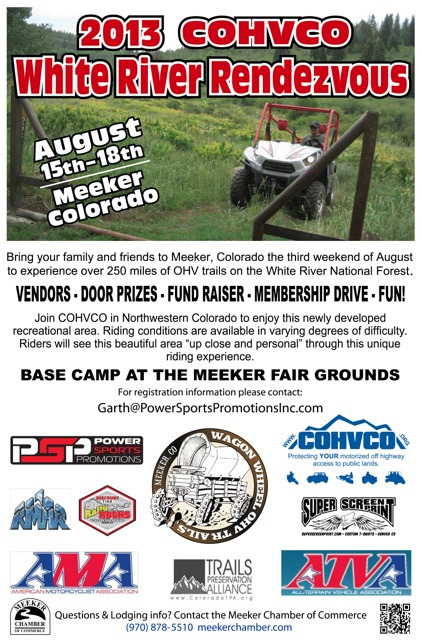David Neely, EHC District Ranger
Att: Paula Peterson
PO Box 190
Minturn CO 81645
Re: Eagle Holy Cross 2013 MVUM update
Dear Mr. Neely:
Please accept this correspondence as the comments of the above Organizations vigorously in favor of the proposal. The Organizations believe the proposal will reduce confusion among all users regarding proper usage of routes on the Eagle/Holy Cross district, impacts will be exceptionally minimal, if there are any identifiable at all, and these changes are entirely consistent with both the 2011 White River Travel Management Plan and White River Resource Management Plan. Any possible concerns regarding the proposal should be further minimized as no new routes or roads are being created. The Organizations share the Districts optimism that the analysis of the entire project can be completed with the issuance of a FONSI.
Prior to addressing the merits of the Proposal, we believe a brief summary of each Organization is needed. The Colorado Off-Highway Vehicle Coalition (“COHVCO”) is a grassroots advocacy organization of approximately 2,500 members seeking to represent, assist, educate, and empower all OHV recreationists in the protection and promotion of off-highway motorized recreation throughout Colorado. COHVCO is an environmental organization that advocates and promotes the responsible use and conservation of our public lands and natural resources to preserve their aesthetic and recreational qualities for future generations.
The Trail Preservation Alliance (“TPA”) is a 100 percent volunteer organization whose intention is to be a viable partner, working with the United States Forest Service (USFS) and the Bureau of Land Management (BLM) to preserve the sport of trail riding. The TPA acts as an advocate of the sport and takes the necessary action to insure that the USFS and BLM allocate to trail riding a fair and equitable percentage of access to public lands.
As noted in the districts scoping letter, this proposal is also fully compliant with the WRF 2011 TMP which notes that management of routes should be on a hierarchical basis.1 The proposed changes are addressing existing routes in the WRNF, which will minimize concerns about possible resource impacts as there is no new routes being constructed and routes are already maintained at sufficient levels for the usages after any changes. Motorized usage of these areas is consistent with designations in place under the existing resource management plan. The Organizations believe these factors weigh heavily in favor of the proposal as both of these documents are newly released and up to date.
The Organizations vigorously support resolution of the proposal as there are no new routes being opened and the proposal may lessen any current levels of impacts. It has been the Organizations experience that travel on roads by OHVs and motorcycles often has less impact on the road way than full-sized licensed vehicles, as OHVs have much softer lower pressure tires and weigh significantly less. Often times licensed trucks and trailers can weigh almost 10,000 pounds when loaded. By comparison an OHV often weighs in the 250-600 pound range.
Any concerns regarding possible sound impacts from changes in usage of the routes should be exceptionally minimal with the proposal, as under Colorado Law OHV may be no louder than 96 dba at 20 inches from the tailpipe which is comparable to a lawn mower, leaf blower or vacuum cleaner. These are exceptionally low levels of sound that should minimize any concerns regarding impacts to wildlife or interference with uses of areas adjacent to the roadways.
The proposal would improve connectivity of routes currently designated for all vehicles, as often current management only permits users to obtain use of a single trail, and then users are required to load their OHV in licensed vehicles to gain access to another single trail that may only be a short distance down the licensed only route. The Proposal would also improve parking safety as users could now connect multiple trails from a single parking area and avoid the need to park on the side of roads.
The Proposal would additionally reduce existing confusion of users regarding usage of routes on the ground. Under current management, users can encounter roads that would appear to be
open to all vehicles but are limited to licensed vehicles only. This is a somewhat unusual situation for most users as most users are familiar with restrictions that encompass areas under certain management standards and once the rider is in the area, routes are generally managed under a similar management standard. The Flattops area provides a good example of possible of confusion of this nature as riders normally enter the Coffee Pot area via FSR 600.1. When accessing the Flattops via 600.1 there is no logical division of usage, other than signage and the MVUM, that would cause riders to believe there is any change in management needed for FSR 622.1 and 623.1. This could result in riders possibly inadvertently missing signs for a variety of reasons and entering FSR 622.1 and 623.1 on the belief that these roads are open to all vehicles, which currently is not the case.
The Organizations are aware that several local motorized clubs are reviewing the existing MVUMs to determine if any additional roads currently limited to licensed vehicles should be amended to address connectivity of routes. It is the Organizations understanding that best efforts are being made to compile this information during the comment period but are unsure if this input will be finalized by the end of the comment period.
Conclusion
The Organizations vigorously support the proposal. If you have questions please feel free to contact Scott Jones at 508 Ashford Drive, Longmont CO 80504. His phone is (518)281-5810.
Sincerely,
Scott Jones, Esq.
COHVCO Co-Chairman
CSA Vice President
Don Riggle
Trails Preservation Alliance
John F. Lane
COHVCO Co-Chairman & President
1 White River National Forest Travel Management Plan, FEIS, Chapter 2 Alternatives pg 34

